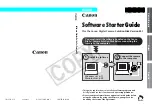
NEC Display Wall Calibrator - UsEr’s GUiDE |
White Point
White Point
selects the Target white point for the calibration. Several popular industry standard White Point
values, such as 9300K and D65, are provided.
A custom white point can be specified by clicking the
Edit...
button to open up the
Custom Color Temperature
dialog.
If the absolute highest possible Intensity is needed for an
application and the White Point does not need to be a particular
value, then the
Calculate Highest Intensity White Point
function can be used to calculate the White Point that gives the
highest overall Intensity. This White Point value is calculated
from the “native” or un-calibrated measurements taken from
all of the displays so all displays should be measured before
using this function. Clicking the
Calculate Highest Intensity
White Point
button will update the current White Point with the calculated value.
Gamma Curve
Gamma Curve
selects the desired tone response curve of the calibrated displays.
Options are:
Monitor Native Gamma
- No correction is applied and the display’s Look Up Tables are set to linear.
Gamma Curve Value
- The response curve will follow a simple gamma curve. Values between 1.0
and 3.0 can be entered. A gamma value of 2.2 is popular for most applications.
DICOM Curve
- The response curve follows the DICOM (Digital Imaging and Communications in
Medicine) specification. This response curve is aimed at medical use, however it can be used for other
applications. The goal of the DICOM response curve is to have a visually linear display response.
Custom Curve
- Advanced and custom response curves can be selected from presets or created by
importing a table of values. Click the
Edit...
button to open the
Custom Gamma Curve
dialog.
Contrast Ratio
Contrast Ratio
allows a particular contrast ratio to be used if necessary. The contrast ratio is the ratio of white
to black luminance.
Selecting
Default
will calibrate the display to the highest possible contrast ratio, which is limited by the display
technology, the selected White Point, Intensity value, and other factors.
In some applications, for example simulating low contrast images
such as in newsprint, it is useful to have a lower contrast ratio than
the display’s native value. Contrast Ratios in the range of 50:1 to
500:1 can be selected.
Note:
If the selected contrast ratio is higher than what the display
is actually capable of achieving, then the display will calibrate to
the highest possible contrast ratio. If a specific
Contrast Ratio
is
selected, it is recommended that the number of
Calibration and
Measurement Steps
be set to at least 32 in the
Preferences
dialog.
•
•
•
•
Содержание Display Wall Calibrator 1.0.00
Страница 1: ...Version 1 0 00 User s Guide ...
















































